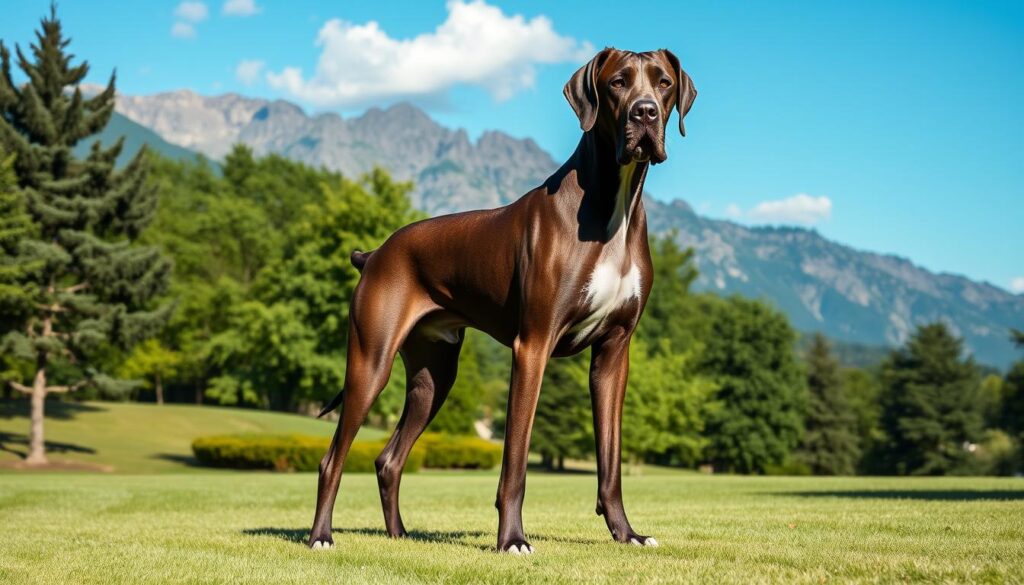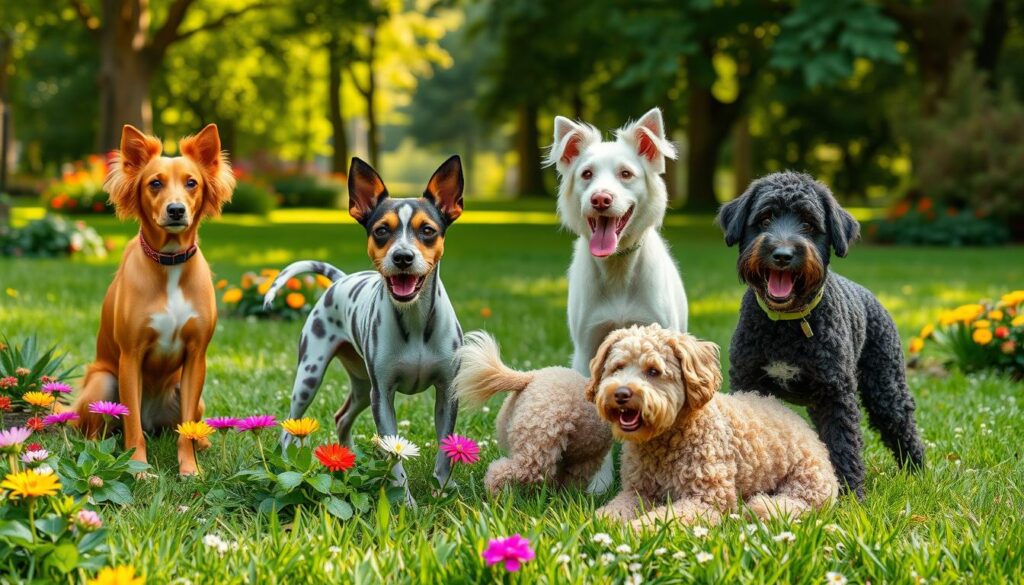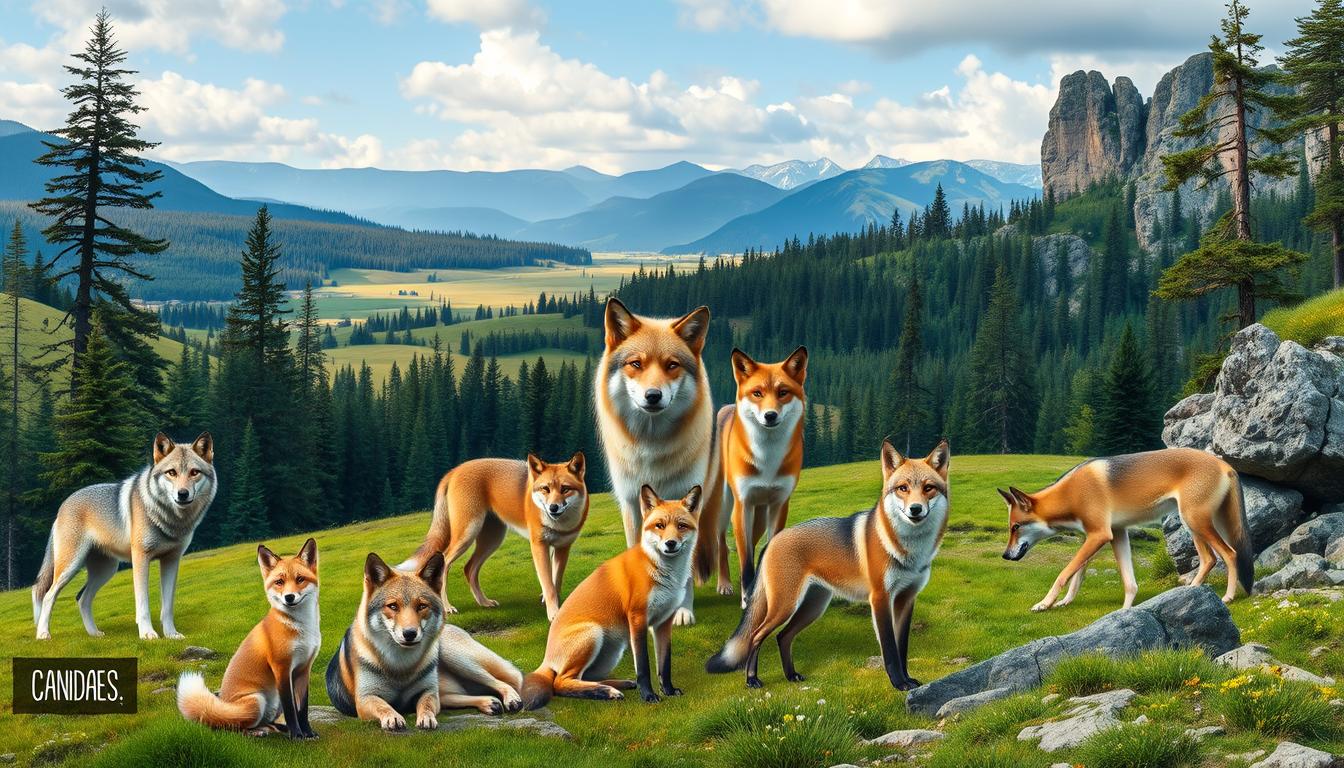The dog, or Canis familiaris, is a domestic species in the Canidae family. This family also includes wolves, foxes, coyotes, and other wild canids. This guide looks at the wide range of dog family members, from wild ancestors to the many domestic dog breeds loved by people all over the world.
The Canidae family, known as the “dog family,” is a group of carnivorous mammals. They include some of the most iconic and fascinating animals on Earth. From the majestic gray wolf to the playful red fox, these canids have evolved over millions of years. They now live in many different habitats and play important roles in their ecosystems. Learning about the evolution and traits of this family helps us understand where our beloved domestic dogs come from.
Key Takeaways
- The Canidae family includes both wild canids and domestic dogs.
- Domestic dogs, Canis familiaris, are a subspecies of the gray wolf, Canis lupus.
- Modern dog breeds have been selectively bred from a diverse gene pool of wild canids and early domestic dogs.
- Canidae family members exhibit a range of physical and behavioral traits, from the swift-footed coyote to the cunning red fox.
- Exploring the Canidae family helps us better understand the origins and diversity of our canine companions.
Understanding the Canidae Family: From Wolves to Domestic Dogs
Exploring how wolves turned into our domestic dogs is fascinating. We look into the Canidae family, which includes our pets and their wild relatives like wolves, coyotes, and foxes.
Evolution of Modern Dogs
The story of the domestic dog starts with wolf ancestors thousands of years ago. They were first tamed, then bred for different traits. This led to the many breeds we see today, showing their long history.
Wild Canids vs. Domestic Dogs
Domestic dogs and wild canids share a common ancestry. But, they’ve changed a lot over time. Wild canids keep their natural ways, while domestic dogs rely on humans and adapt to many homes.
Key Characteristics of Canidae Members
Canidae members share some traits:
- Adaptable and resourceful predators
- Highly social and pack-oriented
- Diverse in size, from the diminutive fennec fox to the majestic gray wolf
- Characterized by a pointed muzzle, upright ears, and a bushy tail
- Exhibiting a wide range of genetic diversity within and between species
By studying the Canidae family, we learn about our dogs’ journey. From their wolf ancestors to the many breeds we love today.
List of Dog Family Members in the Wild
Explore the amazing world of wild canines. Each one has special traits and lives in different places. From the grand wolves in forests to the quick foxes in cities, the dog family is full of wonder.
Learn about the coyotes, who live with humans. See how the jackals find food and stick together. And discover the dingoes of Australia, whose story is still being told.
| Wild Canine Species | Habitat | Unique Adaptations |
|---|---|---|
| Wolves | Forests, tundra, and mountains | Highly social, pack-hunting behavior, and advanced communication skills |
| Foxes | Diverse, from forests to urban areas | Excellent hearing and sense of smell, adaptable to various environments |
| Coyotes | Widespread, from prairies to suburban areas | Opportunistic omnivores, able to thrive in human-dominated landscapes |
| Jackals | Africa, Middle East, and South Asia | Scavenging behavior, strong family units, and adaptability to different habitats |
| Dingoes | Australia | Unique genetic history, adaptations to hot, arid environments, and complex social structures |
These wild canines show the dog family’s amazing diversity and strength. By studying their homes and ways, we learn about their history and how they’ve adapted.
Modern Dog Breed Classifications and Groups
The world of purebred dogs is full of variety and interest. Many breeds are recognized by kennel clubs like the American Kennel Club (AKC). These breeds fall into different groups based on their history, looks, and personality.
Knowing about these AKC breed groups helps us understand the special traits of different dogs.
Working Group Breeds
The Working Group includes dogs bred for jobs like guarding, hauling, and search and rescue. These dogs are strong, smart, and loyal. They include the Rottweiler, Doberman Pinscher, and Bernese Mountain Dog.
Working Group dogs are great at demanding tasks and make loyal friends.
Sporting Group Breeds
The Sporting Group has breeds made for hunting and retrieving waterfowl. Dogs like the Labrador Retriever, Golden Retriever, and Pointer are in this group. They are active, smart, and love the outdoors.
Sporting Group dogs are perfect for families who love to stay active.
Herding Group Breeds
The Herding Group includes dogs that herd and guard livestock. Breeds like the German Shepherd, Border Collie, and Shetland Sheepdog are in this group. They are smart, versatile, and have a strong herding instinct.
Herding Group dogs do well in obedience and agility competitions.
Toy Group Breeds
The Toy Group has small, friendly breeds. Dogs like the Poodle, Chihuahua, and Maltese are in this group. They are small, playful, and great for apartment living.
Toy Group breeds are loved for their cute looks and affectionate nature.
Knowing about these AKC breed groups helps dog owners choose the right breed for them. Whether you want a big Working Group dog or a small Toy Group breed, there’s a perfect dog for everyone.
Popular Large Dog Breeds and Their Origins
Some people love the big size and strong presence of large dog breeds. These dogs are both gentle and loyal. Let’s look at some popular large dog breeds and where they come from.
The Great Dane is a classic big dog. They come from Germany and were once working dogs and guard dogs. Now, they are known for being gentle and great with families.
The Saint Bernard comes from the Swiss Alps. They were used for search and rescue because of their size and strength. Today, they are loved for their loyalty and friendly nature, making them great large family dogs.
- Mastiff: From Britain, Mastiffs were guard dogs and war dogs. They are big, strong, and fiercely protective.
- Newfoundland: From Canada, Newfoundlands were used for water rescue and hauling. They have webbed feet and are very strong.
- Leonberger: From Germany, Leonbergers are large family dogs. They are friendly, gentle, and look like lions.
These are just a few of the amazing giant breeds loved by dog lovers everywhere. Each breed has its own history and traits that make them popular and suitable for different homes.

“The size of these dogs may be intimidating, but their loyal and affectionate nature often belies their impressive stature.”
Small and Medium-Sized Dog Breeds Guide
Looking for the perfect dog? Small and medium-sized breeds have a lot to offer. They range from cute lapdogs to lively medium-sized dogs. This guide will help you understand their unique traits and needs.
Apartment-Friendly Breeds
Living in a small space? Some small dog breeds are perfect for apartments or condos. Companion dogs like Cavalier King Charles Spaniels, Poodles, and Shih Tzus are loyal and love people. They don’t need much exercise, making them great for city living.
Family-Oriented Small Dogs
Want a small lapdog breed that’s good with kids? Pugs, French Bulldogs, and Boston Terriers are great choices. These hypoallergenic dogs are gentle, fun, and love to please. They’re perfect for families.
Active Medium-Sized Breeds
Active lifestyle? Medium-sized breeds are ideal. Terriers like Cairn Terriers and West Highland White Terriers are full of energy. They’re perfect for outdoor fun and play.
| Breed | Characteristics | Ideal Living Environment |
|---|---|---|
| Cavalier King Charles Spaniel | Affectionate, Gentle, Adaptable | Apartments, Smaller Homes |
| French Bulldog | Playful, Companion, Family-Friendly | Apartments, Homes with Yards |
| Cairn Terrier | Energetic, Adventurous, Outdoor-Oriented | Homes with Access to Outdoor Space |
Looking for a cuddly lapdog or an energetic friend? This guide shows you many options. Small and medium-sized dog breeds fit different lifestyles and preferences.
Rare and Unique Dog Breeds Worldwide
The world is full of rare and unique dog breeds. These dogs show the wide range of our canine friends’ genetic heritage. They come from ancient times and include exotic breeds. Let’s look at some of the most interesting rare dog breeds around the world.
Preserving Rare Breeds
Many rare breeds face challenges in keeping their numbers up. They are not as popular as common breeds. But, breeders and conservation groups are working hard to save them. They aim to keep these unique dogs alive and teach us more about them.
Distinctive Features of Rare Breeds
- The Saluki, an ancient sight hound from the Middle East, is known for its elegant, long-limbed appearance and exceptional hunting abilities.
- The Xoloitzcuintli, or Mexican Hairless Dog, is a unique breed prized for its distinctive, often hairless appearance and its reputation as a loyal companion.
- The Samoyed, an ancient herding dog from Siberia, is recognized for its thick, white coat and friendly, affectionate disposition.
Newly Recognized Breeds
Recently, some dog breeds have been recognized by major kennel clubs. This includes the Dogo Argentino, a powerful Argentinian hunting breed, and the Korean Jindo, a versatile companion dog from South Korea.
| Breed | Origin | Distinguishing Features |
|---|---|---|
| Saluki | Middle East | Elegant, long-limbed sight hound |
| Xoloitzcuintli | Mexico | Unique, often hairless appearance |
| Samoyed | Siberia | Thick, white coat and friendly disposition |
| Dogo Argentino | Argentina | Powerful hunting breed |
| Korean Jindo | South Korea | Versatile companion dog |

“Preserving the diversity of dog breeds is crucial for maintaining the rich tapestry of our canine companions.”
Health and Genetic Traits Across Dog Breeds
As pet owners, it’s key to know about the health and genetics of different dog breeds. This includes common inherited conditions, breed-specific health concerns, and factors influencing longevity. We’ll explore these important aspects that affect our dogs’ well-being.
Common Inherited Conditions
Many dog breeds face inherited diseases that can greatly affect their life quality. Conditions like hip and elbow dysplasia, progressive retinal atrophy, and other canine genetics-related disorders are common. It’s vital to do breed health testing and choose breeding wisely to reduce these risks.
Breed-Specific Health Concerns
Some dog breeds have unique breed-specific health concerns. For example, brachycephalic breeds like pugs and French bulldogs often have breathing problems. Larger breeds might deal with joint and skeletal issues. Knowing these concerns helps owners make better choices and care for their pets.
Longevity Factors by Breed
The dog life expectancy varies by breed. Smaller dogs usually live longer, up to 15-20 years. In contrast, larger breeds have a shorter life expectancy, often 8-10 years. Genetics, diet, and health care are crucial in determining a dog’s lifespan.
“Responsible pet ownership involves understanding the unique health and genetic considerations of the breed you choose. This knowledge helps ensure your furry friend enjoys a long, healthy, and happy life.”
Choosing the Right Dog Breed for Your Lifestyle
Finding the perfect dog is a big decision. It needs careful thought about your lifestyle, home, and what you like. Whether you’re new to dogs or have had them before, knowing what different breeds need is key. This helps you pick the best dog for you.
Different breeds have unique qualities and needs. Some need lots of exercise, while others are happy with less. You should also think about grooming, how they get along with kids or other pets, and more. Looking at various breeds helps you find one that fits your life and home well.
Mixed-breed dogs, or “mutts,” can also be great pets. They often have the best traits from different breeds. This makes them special and can mean they’re healthier and live longer. Adopting a mixed-breed from a shelter or rescue is a wonderful way to find a loving pet and help a dog in need.
